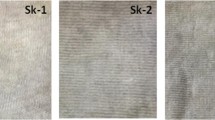Abstract
In this work, the effect of Ag-Fau Y zeolite as a material to inhibit the growth of bacteria on cotton fabric was studied. Different concentrations of silver in the culture of E. coli by the Kirby-Bauer Method were explored. The relevance of this work focuses on the growing concern about the resistance that many bacteria present to antibiotics. In this sense, silver particles have exhibited effective antimicrobial properties, moreover, silver nanoparticles display remarkable effect to inhibit the bacterial growth. The developed material could effectively treat the superficial skin wounds by using an appropriate bandage.
Graphical abstract





Similar content being viewed by others
Data availability
Additional information can be consulted in support information.
References
U. Abdul-Reda Hussein et al., Braz. J. Biol. (2023). https://doi.org/10.1590/1519-6984.264947
A. Rana, A.S. Parmar, Nanotechnol. Environ. Eng. (2022). https://doi.org/10.1007/s41204-022-00301-w
M. Khatami, R.S. Varma, N. Zafarnia, H. Yaghoobi, M. Sarani, V.G. Kumar, Sustain. Chem. Pharm. (2018). https://doi.org/10.1016/j.scp.2018.08.001
J.L. Cerrillo et al., ChemistrySelect (2018). https://doi.org/10.1002/slct.201800432
P. Lalueza, M. Monzón, M. Arruebo, J. Santamaria, Chem. Commun. (2011). https://doi.org/10.1039/c0cc03905e
L. Tosheva, S. Belkhair, M. Gackowski, S. Malic, N. Al-Shanti, J. Verran, Coll. Surfaces B Biointerfaces (2017). https://doi.org/10.1016/j.colsurfb.2017.06.001
M.I. Panayotova, N.N. Mintcheva, O.T. Gemishev, G.T. Tyuliev, G.D. Gicheva, L.P. Djerahov, Bulg. Chem. Commun. 50, 211–218 (2018)
N. Wattanawong, K. Chatchaipaiboon, N. Sreekirin, D. Aht-Ong, J. Reinf. Plast. Compos. (2020). https://doi.org/10.1177/0731684419893440
M. Pesando, V. Bolzon, Cosmetics 9(26), 2022 (2022). https://doi.org/10.3390/cosmetics9010026
K. Rieger, H. Je Cho, H. Fai Yeung et al., ACS Appl. Interfaces Mater. (2016). https://doi.org/10.1021/acsami.5b10130
C. Can, A. Körlü, M. Ateş, Tekst. Konfeksiyon 23(1), 32–37 (2013)
F. Scacchetti, E. Pinto, Preparation and characterization of cotton fabrics with antimicrobial properties through the application of chitosan/silver-zeolite film. Proc. Eng. 200, 276–282 (2017)
S. Koichi Sato, Y. Nishimura et al., Microporous Mesoporous Mater. (2003). https://doi.org/10.1016/S1387-1811(03)00305-6
S. Prabhu, E.K. Poulose, Int. Nano Lett. (2012). https://doi.org/10.1186/2228-5326-2-32
M.M. Salim, N.A.N.N. Malek, J. Adv. Res. Mater. Sci. 36, 1 (2017)
L. Ferreira, A. Fonseca, G. Botelho, C. Almheida-Aguiar, I. Neves, Microporous Mesoporous Mater. 160, 126–132 (2012)
Acknowledgments
The authors gratefully thank CONAHCYT for the postdoctoral fellowship to M. Cruz Leal. We acknowledge the valuable support of the IPNprovided in project SIP-20231327 and the VIEP for the support given in 2023 in project ID-00295. Finally, we thank Nicolás Morales López for the experimental and technical assistance throughout the research project.
Funding
We would also like to sincerely thank the IPN for the support provided in project SIP-20231327 and the VIEP for the support given in 2023 in project ID-00295.
Author information
Authors and Affiliations
Contributions
Study conception and design, MCL; draft manuscript preparation, OG; technical help, TIMN; resources ECG, technical help, AAI, supervision, GFPS, editing JAAC.
Corresponding author
Ethics declarations
Conflict of interest
The authors declare there is no conflict of interest.
Additional information
Publisher's Note
Springer Nature remains neutral with regard to jurisdictional claims in published maps and institutional affiliations.
Supplementary Information
Below is the link to the electronic supplementary material.
Rights and permissions
Springer Nature or its licensor (e.g. a society or other partner) holds exclusive rights to this article under a publishing agreement with the author(s) or other rightsholder(s); author self-archiving of the accepted manuscript version of this article is solely governed by the terms of such publishing agreement and applicable law.
About this article
Cite this article
Cruz-Leal, M., Goiz, O., Niño, T.I.M. et al. Silver cluster supported in zeolite as antimicrobial agent to textiles. MRS Advances 9, 168–171 (2024). https://doi.org/10.1557/s43580-023-00741-9
Received:
Accepted:
Published:
Issue Date:
DOI: https://doi.org/10.1557/s43580-023-00741-9




